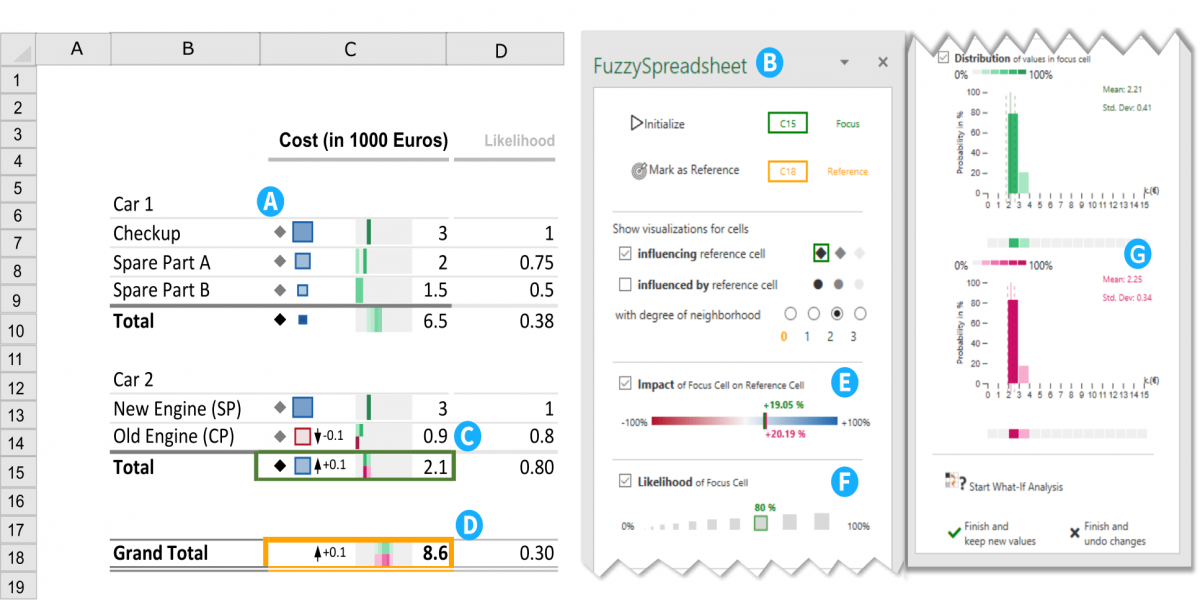
Abstract
Spreadsheet-based tools provide a simple yet effective way of calculating values, which makes them the number-one choice for building and formalizing simple models for budget planning and many other applications. A cell in a spreadsheet holds one specific value and gives a discrete, overprecise view of the underlying model. Therefore, spreadsheets are of limited use when investigating the immanent uncertainties of such models and answering what-if questions. Existing extensions typically require a complex modelling process that cannot be smoothly embedded in a tabular layout. In Fuzzy Spreadsheet, a cell can hold and display a distribution of values. This integrated uncertainty handling immediately conveys sensitivity and robustness information. The fuzzification of the cells enables calculations not only with precise values but with distributions, and probabilities. We conservatively added and carefully crafted visuals to maintain the look and feel of traditional spreadsheet while facilitating what-if analyses. Given a user-specified reference cell, Fuzzy Spreadsheet automatically extracts and visualizes contextually relevant information, such as impact, uncertainty, and degree of neighborhood, for the selected and related cells. To evaluate its usability and the perceived mental effort required, we conducted a user study. The results show that our approach outperforms traditional spreadsheets in terms of answer correctness, response time, and perceived mental effort for almost all tasks tested.
Citation
Vaishali
Dhanoa,
Conny
Walchshofer,
Andreas
Hinterreiter,
Eduard Groeller,
Marc
Streit
Fuzzy Spreadsheet: Understanding and Exploring Uncertainties in Tabular Calculations
IEEE Transactions on Visualization and Computer Graphics,
29(2):
1463-1477, doi:10.1109/TVCG.2021.3119212, 2023.
BibTeX
@article{2021_tvcg_fuzzy-spreadsheets,
title = {Fuzzy Spreadsheet: Understanding and Exploring Uncertainties in Tabular Calculations},
author = {Vaishali Dhanoa and Conny Walchshofer and Andreas Hinterreiter and Eduard Groeller and Marc Streit},
journal = {IEEE Transactions on Visualization and Computer Graphics},
doi = {10.1109/TVCG.2021.3119212},
volume = {29},
number = {2},
pages = {1463-1477},
month = {February},
year = {2023}
}
Acknowledgements
This work was supported in part by the FFG, Contract No. 881844: “Pro2Future is funded within the Austrian COMET Program Competence Centers for Excellent Technologies under the auspices of the Austrian Federal Ministry for Climate Action, Environment, Energy, Mobility, Innovation and Technology, the Austrian Federal Ministry for Digital and Economic Affairs and of the Provinces of Upper Austria and Styria. COMET is managed by the Austrian Research Promotion Agency FFG.” Additional support was granted by the State of Upper Austria and the Austrian Federal Ministry of Education, Science and Research via the LIT – Linz Institute of Technology (LIT-2019-7-SEE-117), and by the Federal State of Upper Austria (Human-Interpretable Machine Learning). This paper was partly written in collaboration with the VRVis Competence Center. VRVis is funded by BMVIT, BMWFW, Styria, SFG and Vienna Business Agency in the scope of COMET—Competence Centers for Excellent Technologies (854174) which is managed by FFG.




